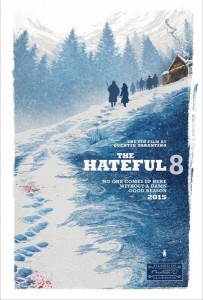 In The Hateful Eight, Quentin Tarantino’s latest film–his eighth– set years (could be six or eight or twelve years) after the Civil War, a stagecoach hurtles through the wintry Wyoming landscape. The passengers, bounty hunter John Ruth (Kurt Russell) and his fugitive Daisy Domergue (Jennifer Jason Leigh), race towards the town of Red Rock where Ruth, known in these parts as “The Hangman,” will bring Domergue to justice.
In The Hateful Eight, Quentin Tarantino’s latest film–his eighth– set years (could be six or eight or twelve years) after the Civil War, a stagecoach hurtles through the wintry Wyoming landscape. The passengers, bounty hunter John Ruth (Kurt Russell) and his fugitive Daisy Domergue (Jennifer Jason Leigh), race towards the town of Red Rock where Ruth, known in these parts as “The Hangman,” will bring Domergue to justice.
Along the way in this strange road film, they encounter two strangers: Major Marquis Warren (Samuel L. Jackson), a black former union soldier turned infamous bounty hunter, and Chris Mannix (Walton Goggins), a southern renegade who claims to be the town’s new Sheriff.
Losing their lead on the bliz zard, Ruth, Domergue, Warren and Mannix seek refuge at Minnie’s Haberdashery, a stagecoach stopover on a mountain pass. When they arrive at Minnie’s, they are greeted not by the proprietor but by four unfamiliar faces. Bob (Demian Bichir), who’s taking care of Minnie’s while she’s visiting her mother, is holed up with Oswaldo Mobray (Tim Roth), the hangman of Red Rock, cow-puncher Joe Gage (Michael Madsen), and Confederate General Sanford Smithers (Bruce Dern).
As the storm overtakes the mountainside stopover, and constrains the eight travelers in a limited and dangerous space, each one of them begins to realize that he or she may never make it to Red Rock.
Trust: On Screen and Off
That irony that The Hateful Eight is dealing with the issue of trust wasn’t lost on me, especially since I was trying to write this a little differently than I had written before. I usually do a bunch of different drafts and then worked on this one draft and the end is the end. I wanted to get to a first draft and not worry about the second half of it and see where it goes. I was going to do three drafts and eventually figure some things out by that third draft. That’s why it was so weird to have the first draft leaked out there, because it was an unfinished cake and it had no ending–it was just an ending. But it actually required me–since I am writing a mystery–to be detective about the whole thing.
I wanted to play with the idea of trust, namely, that in today’s world, nobody can get away with lying about almost anything, and there is so many clues, your fingerprints and the ID’s. If you do anything in this world, you get put on a list to some degree or another, and you really can’t disappear anymore.
But in the 1800s, when people showed up and said who they were, you either had to believe or not, there was no backup to any of this. I liked the idea of a movie where a bunch of characters are trapped in a situation, and nobody can trust what anybody says about who they are.
We the audience have absolutely no solid ground as far as what is concerned. But even more important, I wanted people to make claims about themselves and describe themselves, but never let the audience know if are they telling the truth, or are they not telling the truth?
I wanted to bring up a few different questions about the characters and then have you make a decision yourself about whether or not they are telling the truth? For example, is Chris Mannix the sheriff of Red Rock or is he not? Did Major Warren actually do what he said he did to General Smithers’ son? Are there fifteen extra gang members waiting it out in Red Rock? The idea behind that was that I want you to make those decisions and I want you to answer those questions. And depending on how you answer those questions, you had a different view of the movie than a person who answers them in a different way.
Auteur: Overall Themes in Work
There are some thematic strains in my work, like the way that minerals will have strains through rock. I don’t know if I am really the one to put a label on it and to title it, and I think that is more up to you guys, critics and journalists, to look at it and collect themes. I can see certain things: I have dealt with race to one degree or another, lightly or differently or glancingly, in almost all my movies.
But there is an aspect of masquerade and performance–all my characters are really good actors. And I don’t keep trying to do this, but it just keeps happening. In every single one of my movies, there is some section where a character pretends to be somebody he is not and presents a false idea of themselves. The story is about them pulling off this masquerade, and sometimes they are more successful at it than others.



